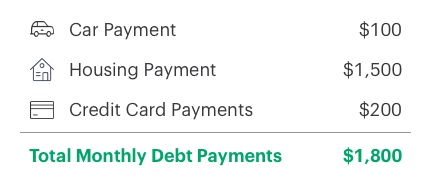Debt-to-Income Ratio: How to Improve Yours
Your debt-to-income ratio is a key factor that lenders use to decide whether you can afford to take on more debt and make another monthly payment. A good debt-to-income ratio can make the difference between being approved or declined for credit, so it’s essential to know your debt-to-income ratio and take steps to improve it.

What is debt-to-income ratio?
Your debt-to-income ratio measures how much you owe each month compared to how much you earn. It’s calculated by dividing your total monthly debt payments by your total monthly income. Debt-to-income ratio (sometimes called DTI ratio) is one of many factors that lenders use to evaluate your ability to manage your debt and your monthly payments.
The lower your debt-to-income ratio, the less risky you appear to lenders. A higher debt-to-income ratio suggests that you might be overextended and would have hard time repaying additional debt.
How do I calculate my debt-to-income ratio?
Calculating your debt-to-income ratio is simple. First, add up all your monthly debt bills (such as a car payment, rent or housing payment, and credit card payments). Next, divide that number by your total monthly income before taxes. The result is a percentage known as your debt-to-income ratio. Here’s an example:
Debt payments

Income


Where do lenders get the information to calculate your debt-to-income ratio? It depends, and every lender is different. Most debt information can be found on your credit report, but many lenders will also ask you for some or all of your debt payment information as part of the application process. Your income is not included on your credit report, so almost every lender will ask for your self-reported income as part of the up-front application process. It’s important to be as accurate as possible when you provide your income, since most lenders will perform some verifications to ensure you actually make what you say you make.
How do lenders use debt-to-income ratio?
Lenders use debt-to-income ratio to gauge how well you’ll be able to handle additional debt and debt payments. The lower your debt-to-income ratio, the less risky you appear to potential lenders and the more likely you are to be approved. A higher debt-to-income ratio suggests that you might be overextended and would have a hard time repaying additional debt. If a lender doesn’t think you can handle more debt, they may reject your application altogether, or they may only offer you a small amount of money that they think you can manage to repay.
Even though your debt-to-income ratio is not found directly on your credit report, it is an important factor that impacts your ability to secure credit. Focusing on improving your debt-to-income can help you gain access to affordable credit in the future. Learn more about what else lenders use to evaluate applicants beyond your credit report.
What is a good debt-to-income ratio?
Most lenders don’t advertise a maximum debt-to-income ratio, so there isn’t a magic number. That said, the lower the better and generally staying below 40% is best. Debt-to-income ratio requirements also vary based on the type of credit you’re applying for. For example, 43% is usually the highest DTI you can have and still get a qualified mortgage.1
How can you improve your debt-to-income ratio?
There are two ways to lower your debt-to-income ratio: lower your debt levels or increase your income.
For most of us, increasing our income is easier said than done. If a high debt-to-income ratio is preventing you from getting access to credit that you need, some lenders may allow you to apply with a co-applicant or add a co-signer to your loan and have that person’s income considered as part of your application. Although this may help you get approved for credit, it won’t actually lower your personal debt-to-income ratio.
The other way to improve your debt-to-income ratio is to lower your debt levels:
- Stop taking on more debt. Don’t apply for new credit, avoid running up your credit card balances, and delay any major purchases.
- Pay down existing debt. Evaluate different strategies for paying down your debt. For example, you might be able to streamline and lower your monthly debt payments with a debt consolidation loan, or you may be able to temporarily save on your monthly credit card bill with a balance transfer offer.
- Reduce your spending for the long haul. Revisit your budget to figure out where your money is going each month. Consider putting in place some better money habits to nudge yourself toward a more frugal lifestyle, and check out some hacks to avoid overspending. Use any extra money you have each month to make extra payments on your existing debts.
Bottom Line
Your debt-to-income ratio is not included in your credit report or your credit score, but it is an important number to know because it’s a key financial health indicator that shows lenders if you’re living within your means. Plus, if you have a high debt-to-income ratio you might also have a high credit utilization ratio, which does have a major influence on your credit score.


